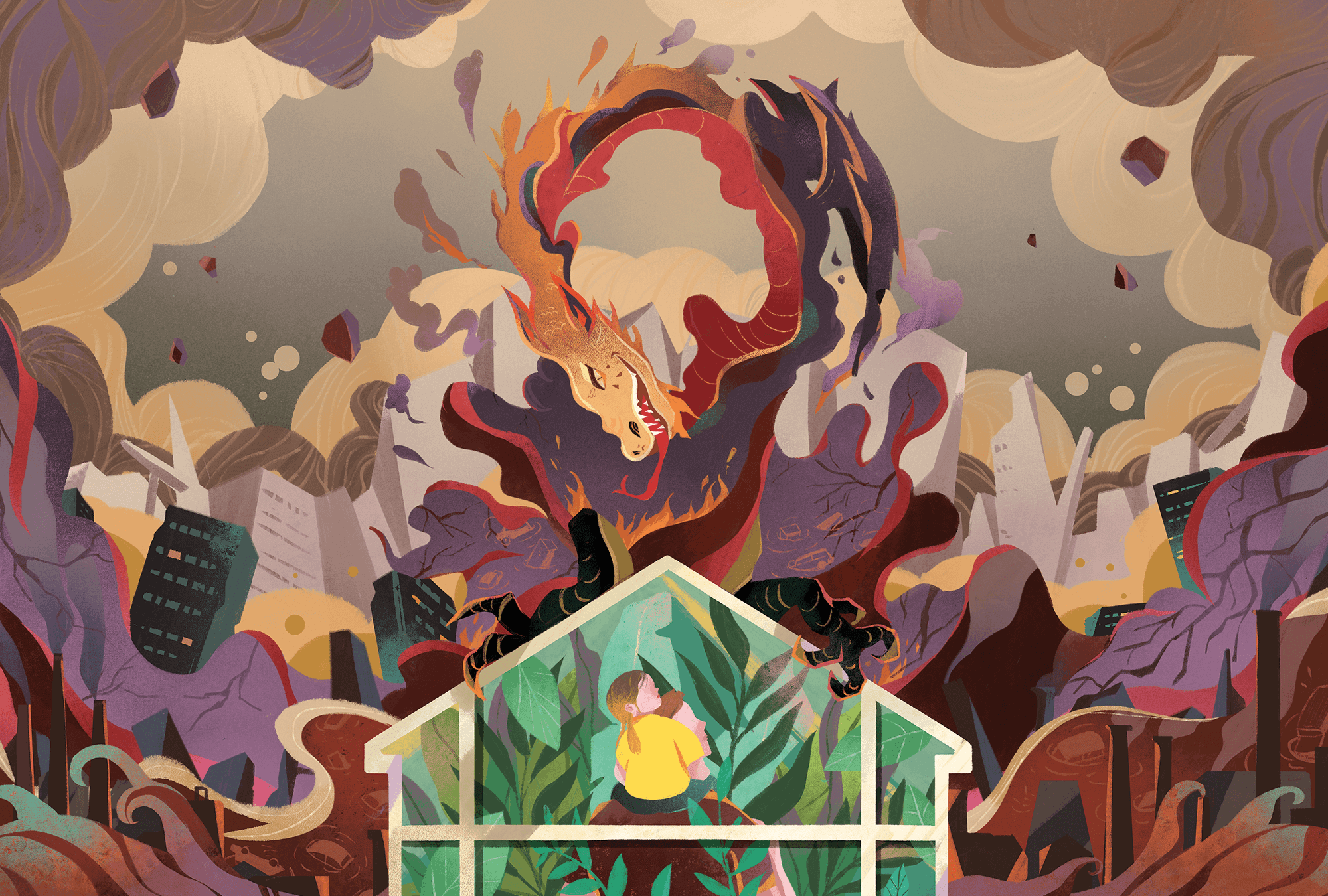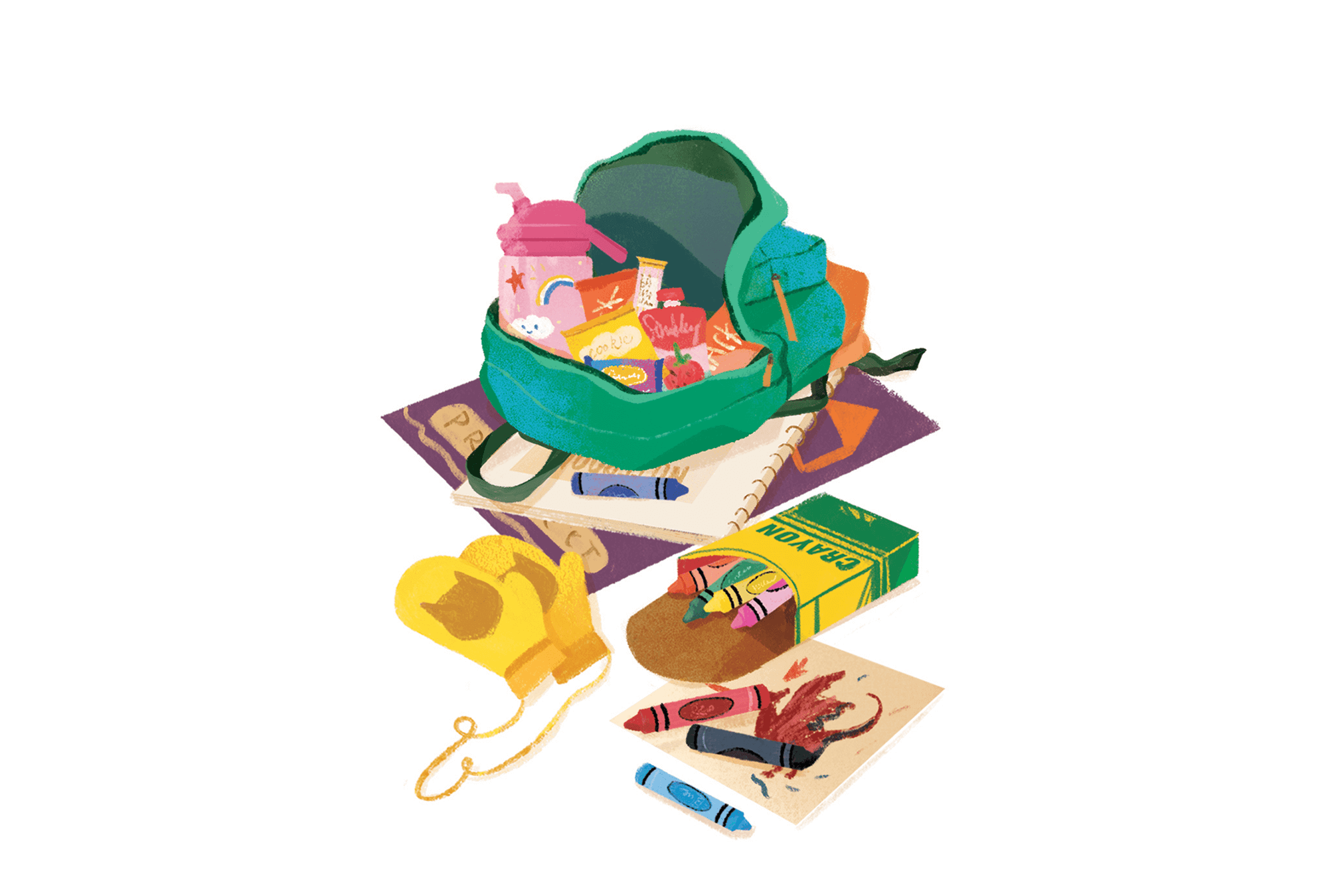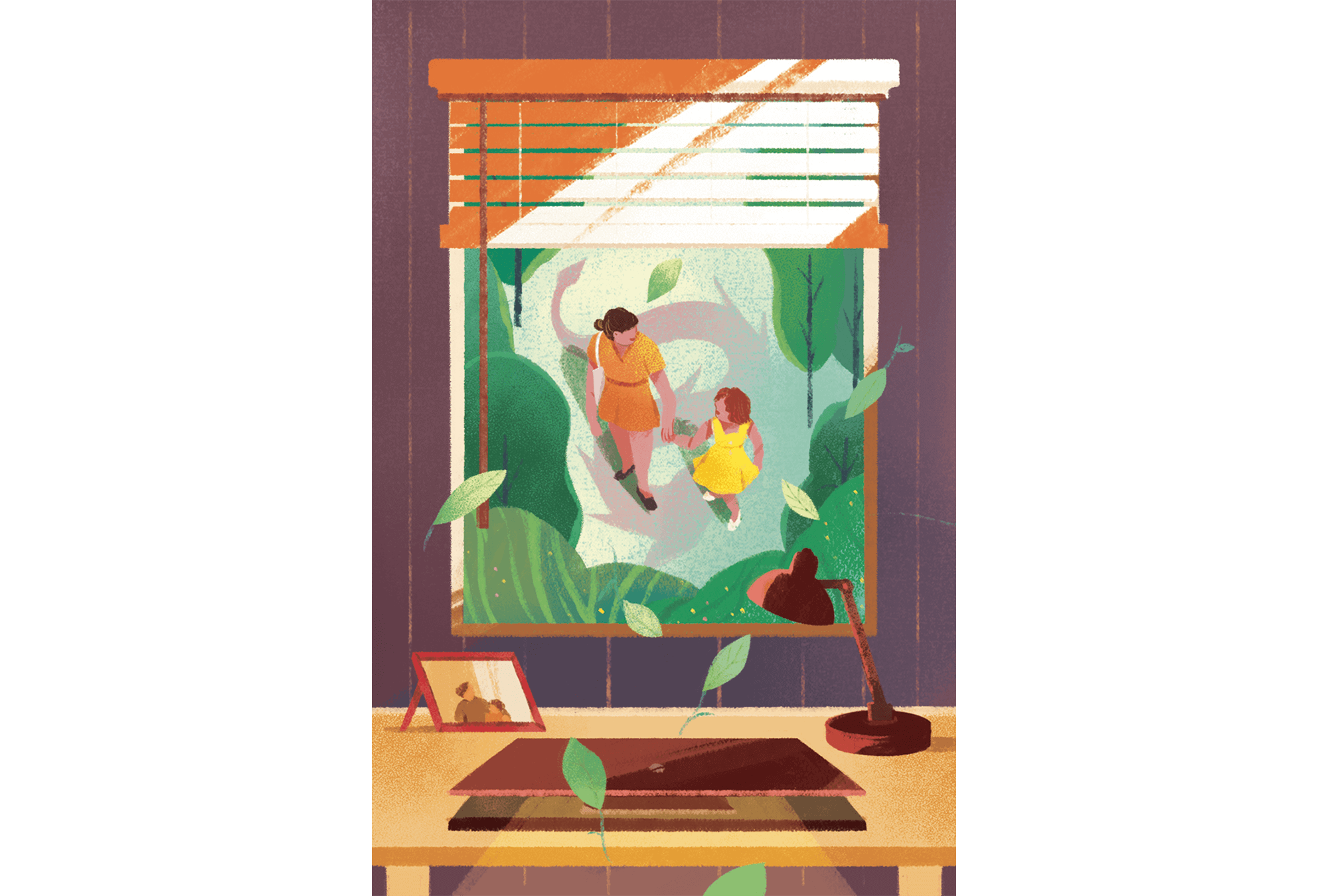Share As A Gift
Share a paywall-free link to this article.
This feature is only available for subscribers.
Start your subscription for as low as $4.95. Already a subscriber?

Illustration by Jianan Liu
“MOMMY, WHY DON'T people care about the trees?”
I lay on the floor feeling the weight in my chest. I can hear a constellation of starlings gathering in the silver maple out my window. Every breath takes work to keep the airways open against the anxiety that has grasped my body. My youngest’s question was haunting me.
How on earth are we supposed to parent in this moment? Climate catastrophe is upon us. We will know its touch, if we haven’t already, and our children will certainly know it. How do we keep grounded as we move from one crisis to the next?
I reach for a cassette labeled “Jeanie Wylie-Kellermann workshop, 1991.” I blow off the dust and stick it in the tape player. Out comes a voice that was once as common as daily bread: my mother’s voice. Sixteen years after her death, I hear her, clear and steady.
She reads Revelation 12: “A woman clothed with the sun, with the moon under her feet, with 12 stars on her head for a crown. She was pregnant and in labor, crying out in pain as she was about to give birth.” I listen as my belly, still etched with the stretch marks from when my own body groaned with creation, rises off the floor. “The dragon stood before the woman about to deliver, to devour her child the moment she gave birth.”
I keep breathing; yes, I know this old dragon. And I cry out with this woman and hunger for her company.
In a 1991 article for The Witness magazine, my mom further explicated this woman giving birth in the face of the dragon: “She is classically understood (by the Catholics at any rate) to be an image of Mary the mother of God. But she is powerful and honored by God. She has dominion. All this while she is in labor, surrendering to the onslaught of life that will come, assent or no. And this woman takes this role even though, at her feet, there waits a dragon whose reason for being is to devour her child.”
Today, in my city of Detroit, Jeanie’s exegesis remains piercing. “The dragon” now disguises itself as the spirit of a “comeback city,” while at the same time turning off water service to homes and threatening privatization. The dragon uses the Marathon oil refinery 4 miles from our home to poison the air. The dragon lives in children’s asthma-swollen lungs and pours raw sewage from combined sewer systems into basements and the river when the rain falls hard. The dragon of environmental racism knows no bounds.
My own babies, Isaac and Cedar, are now 8 and 5. They climb the same trees I did as a kid in southwest Detroit. This is Anishinaabe land named Waawiyatanong (“where the water goes round”).
PARENTING IN THESE days requires educating our children about this dragon. We cannot hide the dragon. They too will have to look it in the eye. How do we help them be ready?
Engaging climate change with our kids can feel insurmountable. We know their beautiful minds will have endless and powerful questions and yet we have no answers. What is going to happen? I don’t know. How do we fix it? I don’t know. Will we be okay? I don’t know. It’s a parental tendency to not tell our kids about a thing until we know how we want to say it and have some answers at hand—especially when it is a moment of life or death. But, in the case of climate change, we just can’t do it that way.
My partner and I held these uncertainties as we discerned and yearned for kids of our own. We understood that parenting in this era meant dealing with the climate crisis. We are required to entrust what we most love to the unknown future. Our kids are not a reason to flee the danger, but to face it. They have forced us to be even more intentional about how we think about money, time, and technology. We make commitments around growing food and sharing resources with our neighbors. We try to make do with one car and a handful of bikes. We have deepened our roots on this street where I was raised—and they are raised—by prioritizing community. We cannot and will not shield them from injustice in the world around them.
We welcome children into a vulnerable space of fear and uncertainty. And that is a beautiful thing. Trust these hallowed spaces of unknowing to be fertile ground for our kids’ imaginations and for all our hearts to grow.
PERHAPS THE MOST urgent work that we can do is to teach our children to learn the sacred ecosystem where God’s secrets are tucked away, where their own bodies grow and dwell. To paraphrase Baba Dioum, a Senegalese environmentalist, “You can’t save a place you don’t love. You can’t love a place you don’t know. And you can’t know a place you haven’t learned.”
My kids often notice what I miss. This means we lie down on the dirt with them and watch the leaves of the milkweed disappear as the caterpillar grows fat. Or we run outside after bedtime to watch the snow fall under the moon, catching those early snowflakes on our tongues.
They invite me into holy awe and gratitude, releasing my grasp on the clocks of capitalism and the glorification of screens. Responsibilities and schedules are undeniable, but finding ways to let them go now and then allows our children to shift their posture, and even our own, toward an intimacy with the earth. Children have a way of recalibrating our clocks to kairos time.
We put boundaries on Zoom calls and screen time, not just for our kids, but for ourselves as well. We make time to walk slowly through the woods, nibbling on wild grape vines, clover flowers, and wild carrot. As my kids climb over logs or encounter the hiding salamander, their souls seem at rest. They are falling in love.

Illustration by Jianan Liu
IN GENESIS, GOD invites humans into the intimate work of calling creatures by name. In our backyard, my kids are quick to cry out in delight: “tufted titmouse,” “chickadee,” or “red-tailed hawk.”
Naming, language, being, and relationship are interconnected parts of our ancient story. As these creatures disappear, our vocabulary does too. Over the past 15 years, tech words have replaced nature words in children’s dictionaries. “Broadband,” “block graph,” and “cut and paste” have pushed out “acorn,” “willow,” and “dandelion.” In 2007, the Oxford Junior Dictionary removed more than 50 nature words and another 50 in 2012. The Lost Words, a children’s book written by Robert Macfarlane and illustrated by Jackie Morris, is a beautiful collection of creature illustrations and poetry written in response to the grief of how children’s language is changing. How will our children notice the red-winged black birds disappearing if they don’t know what they are called?
So, we learn their names. We let our bird identification book become tattered and stained. We pause to figure out if the tree is a red oak or a white oak.
Learning the names of plants and creatures becomes an act of resistance to the all-consuming dragon. These names fall from our tongues as a ritual of remembrance. As Christians, we know the power of communal naming and remembering that we find in the sanctuary each week. We say the words again and again, generation to generation. May we add the sacred names of honeybee and trillium into our collective liturgies so that if they begin to go silent, we will notice.
THIS SUMMER, U.N. Secretary-General António Guterres noted that the most recent intergovernmental climate change report was “a code red for humanity. ... Global heating is affecting every region on Earth, with many of the changes becoming irreversible.”
The U.S. infrastructure is crumbling under the weight of extreme weather. My kids have already witnessed trucks and cars submerged under 9 feet of water on the freeway near us. They have watched scuba divers search for bodies. How will they cope when the water is higher? How will children stay cool in 120-degree weather? What will they eat when the supply chain collapses?
And how will they find joy? When the electrical, plumbing, and cell phone grids collapsed under the floods last summer, our whole neighborhood brought grills to the front lawn and feasted on the thaw from our freezers. Amid anxiety, we found a way to create a festival.
We usher our kids into a schooling system designed not for climate resilience but for industrialization. They are prepped for factories or desk jobs by listening to bells and learning obedience. This old way won’t serve them as the climate grows more unpredictable. Education for this moment requires that we relearn what our bodies have forgotten. My kids are learning to pick up knitting needles and work a sewing machine. We are putting seeds in the earth and raising chickens. We chop firewood, shovel compost, and make jam. There are adults in their lives who know how to do plumbing, electrical, and construction, and friends who play piano, throw pottery, gather medicinal herbs, and tend beehives.
Little by little, we expand our community. We find our way back into work that is gentler on the earth. Slowly we entrust our children to be held, not by us, but by all of creation.
SO MUCH OF our children’s future with climate change is unpredictable, but one thing is certain. They will face death ... of species, of ecosystems, and of human beings. I want my children to be able to touch death. To look it in the eye. To honor the dead. To cry and give thanks and return bodies to the earth.
So, we throw a lot of funerals. We have buried every pet fish, a couple of pet rabbits, and a host of stray cats. We dig a hole together. We tell stories. We touch the bodies. We offer prayers. And we sing. There is a lot of singing. It is holy time.
This year when the Día de los Muertos altar was built at our kids’ school, Isaac brought a drawing of his Grandma Jeanie. They never met in the flesh, but he feels her kindred spirit as he too delights in endless hours playing in snow and wave-jumping in the Great Lakes. He wrote on his drawing “My Grandma Jeanie died 16 years ago from brain cancer. She loved it outside. I hope you are happy.”
Cedar too remembered her when we lit our communal Samhain fire, the Gaelic festival honoring the harvest time when the veil between the living and the dead is thin. He reached for a handful of wood shavings and threw them into the fire as he called her name. Handful after handful, the fire burst and popped as he called soup-kitchen guests, grandparents, and beloved chickens into the circle.
When my children are faced with death, I want them to remember these rituals in their bones. I want songs and prayers to tumble out of their mouths.
ON THE DAYS when my own fear gets the better of me, I find my way into the streets. Protests are one of those places where we reach out for another’s hand and realize we aren’t alone.
The dragon is circling. While on one hand we keep birthing new life and new dreams, on the other, we show up to resist the dragon. There is not one power or principality responsible for the climate collapse, but a tangled web of energy, technology, and agricultural industries, global corporations, capitalism, nationalism, white supremacy, and dare we also name some versions of Christianity. It is powerful enough to make us collapse with despair. But we bring our bodies and show up. We name and expose. We resist because we cannot do otherwise. In the words of Catholic priest Daniel Berrigan, “Don’t just do something, stand there.”
When anger and grief pour out on the street, it becomes church. Holy rage held with many voices in the public square gives way to hope. Collectively, we can hold back the dragon.
So, we bring the kids along. We pack endless snacks and mittens. With markers and crayons, they create often ridiculous and lovely signs. And we go—even if only for a few minutes. Because I want them to feel the collective creativity and power of community. I want them to release their rage. I want them to learn how to fight like hell for the living.

Illustration by Jianan Liu
IN 2019, I interviewed 90-year-old Joanna Macy, a scholar of Buddhism and respected voice in the anti-nuclear movements and deep ecology, for Geez magazine. “I’m grateful for those who choose mindfully, with clear understanding, to bear children into this time. Because we’re going to need those newcomers coming in through the passage of collapsing society, carrying the grief, and moving forward into a life-sustaining culture that can be born of this,” she said.
How true that is. One Swedish student, Greta Thunberg, strikes from school on Fridays to demand action on climate change and fans a worldwide movement. Six young people from Portugal have taken 33 countries to the European Human Rights Court for failing to do their part in stopping the effects of climate change. Two young women in Australia rappel from huge coal-handling machinery to shut down the largest coal shipping port in the world.
A new generation is leading the way. The responsibility is not and should not be on young people alone. But thank God for their imagination, their clarity, and their sense of urgency. Our job is to become listeners to the young people on the front lines, and to the little ones in our arms in the dark of night who ask, “Why don’t people care about the trees?”
WHEN I WAS 5 years old, my mom wrote: “The dragon is real. We can feel his breath. We know the dragon’s cruelty and voracious hunger in the movements of imperial power and in the personal cold anger and hatred. And within us is something waiting to be born, something God-given and sacred. Something small and frail and dependent on us for its very blood and growth.”
I look now at Cedar, my own 5-year-old, and know the dragon remains. There are days I fear there is no hope left.
And yet we give birth. And yet we witness these children continuing to dream on this sweet Earth. I never doubt for a second the power and mystery of labor in our collective bodies. The work, the time, the life before us is beautiful, and we can fill it with love and joy even amid collapse.
As 8-year-old Isaac said, “I hope for so many things, but it will be hard. I want all the animals to be safe. I want everybody, including animals, to live a happy life enjoying their life. Living with no pollution. Living free.”
This is how we defeat the dragon. Revelation 12:14 says when the woman resisted the dragon, she was “given the two wings of a great eagle, so that she might fly to the place ... out of the serpent’s reach.” She protected the child—the child who leads to freedom.
My beloved children,
who were knit in your mother’s womb deep in the depths of the earth,
You too were called by name along with the cedar tree, the red-bellied woodpecker, and the black bear.
May you lie under a sky full of stars and feel yourself entirely rearranged.
May you return home to the same tree year after year
knowing the smell of the leaves each changing season.
Join your sacred groan to that of creation. May it never cease.
Trust your body. Let it guide you. And one day let it return to the soil as food.
Let your life be an answer to the earth’s prayers.
Got something to say about what you're reading? We value your feedback!